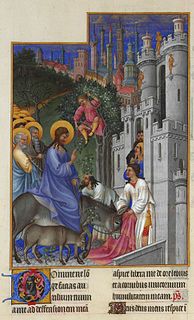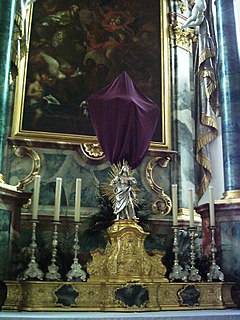Quinquagesima is one of the names used in the Western Church for the Sunday before Ash Wednesday. It is also called Quinquagesima Sunday, Quinquagesimae, Estomihi, Shrove Sunday, or the Sunday next before Lent.

Carnival is a Western Christian festive season that occurs before the liturgical season of Lent. The main events typically occur during February or early March, during the period historically known as Shrovetide. Carnival typically involves public celebrations, including events such as parades, public street parties and other entertainments, combining some elements of a circus. Elaborate costumes and masks allow people to set aside their everyday individuality and experience a heightened sense of social unity. Participants often indulge in excessive consumption of alcohol, meat, and other foods that will be forgone during upcoming Lent. Traditionally, butter, milk, and other animal products were not consumed "excessively", rather, their stock was fully consumed as to reduce waste. Pancakes, donuts, and other desserts were prepared and eaten for a final time. During Lent, animal products are no longer eaten, and individuals have the ability to give up a certain object or activity of desire.

Great Lent, or the Great Fast, is the most important fasting season in the church year in the Eastern Orthodox Church, Byzantine Rite Lutheran Churches and the Eastern Catholic Churches, which prepares Christians for the greatest feast of the church year, Pascha (Easter).

The liturgical year, also known as the church year or Christian year, as well as the kalendar, consists of the cycle of liturgical seasons in Christian churches that determines when feast days, including celebrations of saints, are to be observed, and which portions of Scripture are to be read either in an annual cycle or in a cycle of several years.

Holy Week in Christianity is the week just before Easter. It is also the last week of Lent, in the West, – Palm Sunday, Holy Monday, Holy Tuesday, Holy Wednesday, Maundy Thursday, Good Friday, and Holy Saturday – are all included. However, Easter Day, which begins the season of Eastertide, is not. However, traditions observing the Easter Triduum may overlap or displace part of Holy Week or Easter itself within that additional liturgical period.

Marzanna, Marena, Morana, or Morena or Kyselica, Morena, Maslenitsa and also Mara, Maržena, Moréna, Mora or Marmora, Morė is a Slavic goddess associated with seasonal rites based on the idea of death and rebirth of nature. She is an ancient goddess associated with winter's death and rebirth and dreams. In Slavic rites the death of the Goddess Marzanna at the end winter, becomes the rebirth of Spring of the Goddess Kostroma (Russian), Lada, Vesna representing the coming of Spring.

In the liturgical year of some Christian denominations, Passion Sunday is the fifth Sunday of Lent, marking the beginning of the two-week period called Passiontide. In 1969, the Roman Catholic Church removed Passiontide from the liturgical year of the Novus Ordo form of the Mass, but the day remains observed on the fifth Sunday in the Extraordinary Form mass, as well as by the Anglican Communion and by Lutherans.

An effigy is a representation of a specific person in the form of sculpture or some other three-dimensional medium. The use of the term is normally restricted to certain contexts in a somewhat arbitrary way: recumbent effigies on tombs are so called, but standing statues of individuals, or busts, are usually not. Likenesses of religious figures in sculpture are not normally called effigies. Effigies are common elements of funerary art, especially as a recumbent effigy in stone or metal placed on a tomb, or a less permanent "funeral effigy", placed on the coffin in a grand funeral, wearing real clothing.
Lent, in Western Christianity, is the period before the Christian holy day of Easter.

Eastertide or Paschaltide is a festal season in the liturgical year of Christianity that focuses on celebrating the Resurrection of Jesus Christ. It begins on Easter Sunday, which initiates Easter Week in Western Christianity, and Bright Week in Eastern Christianity. There are several Eastertide customs across the Christian world, including sunrise services, exclaiming the Paschal greeting, clipping the church, and decorating Easter eggs, a symbol of the empty tomb. The Easter lily, a symbol of the resurrection, traditionally decorates the chancel area of churches throughout Eastertide. Other Eastertide customs include egg hunting, eating special Easter foods and watching Easter parades.

Plough Monday is the traditional start of the English agricultural year. While local practices may vary, Plough Monday is generally the first Monday after Twelfth Day (Epiphany), 6 January. References to Plough Monday date back to the late 15th century. The day before Plough Monday is sometimes referred to as Plough Sunday.

The burning of Judas is an Easter-time ritual originated in European Christian communities, where an effigy of Judas Iscariot is burned. Other related mistreatment of Judas effigies include hanging, flogging, and exploding with fireworks. Anthropologists generalize these types of activities as "scapegoating rituals". A similar ritual in Jewish tradition would be the hanging and burning an effigy of Haman and his ten sons during Purim.
Shrovetide, also known as the Pre-Lenten Season, is the Christian period of preparation before the beginning of the liturgical season of Lent. Shrovetide starts on Septuagesima Sunday, includes Sexagesima Sunday, Quinquagesima Sunday, as well as Shrove Monday, and culminates on Shrove Tuesday, also known as Mardi Gras. One hallmark of Shrovetide is the merrymaking associated with Carnival. On the final day of the season, Shrove Tuesday, many traditional Christians, such as Anglicans, Lutherans, Methodists and Roman Catholics, "make a special point of self-examination, of considering what wrongs they need to repent, and what amendments of life or areas of spiritual growth they especially need to ask God's help in dealing with."

The Fight Between Carnival and Lent is an oil-on-panel work painted by Pieter Bruegel the Elder in 1559. This painting depicts a common festival of the period, as celebrated in the Southern Netherlands. It presents the contrast between two sides of contemporary life, as can be seen by the appearance of the inn on the left side—for enjoyment, and the church on the right side—for religious observance.
Nickanan Night is a Cornish feast, traditionally held during Shrovetide, specifically on the Monday before Lent.

Lazarus Saturday in the Eastern Orthodox Church and Oriental Orthodoxy is the day before Palm Sunday to which it is liturgically linked. It celebrates the raising of Lazarus of Bethany, the narrative of which is found in the Gospel of John.

Holy Week in Mexico is an important religious observance as well as important vacation period. It is preceded by several observances such as Lent and Carnival, as well as an observance of a day dedicated to the Virgin of the Sorrows, as well as a mass marking the abandonment of Jesus by the disciples. Holy Week proper begins on Palm Sunday, with the palms used on this day often woven into intricate designs. In many places processions masses and other observances can happen all week, but are most common on Maundy Thursday, Good Friday, Holy Saturday and Easter Sunday, with just about every community marking the crucifixion of Jesus in some way on Good Friday. Holy Saturday is marked by the Burning of Judas, especially in the center and south of the country, with Easter Sunday usually marked by a mass as well as the ringing of church bells. Mexico's Holy Week traditions are mostly based on those from Spain, brought over with the Spanish conquest of the Aztec Empire, but observances have developed variations in different parts of the country due to the evangelization process in the colonial period and indigenous influences. Several locations have notable observances related to Holy Week including Iztapalapa in Mexico City, Taxco, San Miguel de Allende and San Luis Potosí.
















